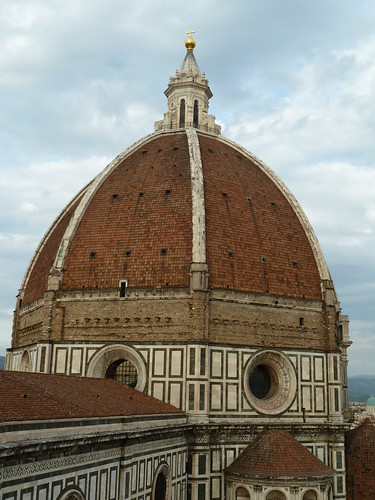 The Renaissance in Florence was a time of dazzling accomplishments, not only in art but also in architecture, and the (literally) crowning achievement is Brunelleschi's dome atop the Florence cathedral. When the cathedral was begun in 1296, Arnolfo di Cambio, the original architect, built a scale model to illustrate his design, which included a huge dome on an octagonal drum. The design was audacious, in that no one at that time had any idea how to build such a structure without it collapsing under its own weight. Nonetheless, the patrons of the cathedral clung to that bold vision, and when the nave was completed in 1380, they would wait for 40 more years with a huge hole in the ceiling of their cathedral until an architectural genius arrived on the scene with a solution. Filippo Brunelleschi devised ingenious solutions to numerous challenges that stood in the way of building the dome. First, there was the structural problem. While a perfectly round dome, like Rome's Pantheon, can support itself because of the special properties of circles and spheres to evenly distribute their weight stress, Florence's dome was meant to be octagonal rather than round in its footprint, and elongated in its height. These design elements make the dome especially graceful in appearance, but also make it inherently unstable. The solution was to build an interior dome which was more spherical, to bear the weight, and then an outer dome with the more graceful (but non-self-supporting) proportions resting on the inner dome. That design would be stable once it was built, but the next problem was how to support it as it was being constructed. Often, domes would be supported with a temporary wooden scaffolding while they were being built, but the scale of the cathedral's dome made that impossible. The opening at the base of the dome was 170 feet off the ground and spanned nearly 150 feet across. There were not trees enough in all of Tuscany to erect a scaffolding that big. Brunelleschi devised more creative solutions, including a herringbone pattern of laying brickwork that could support its own weight across an incomplete arch while the mortar was not yet dry. And he came up with many new mechanical inventions in order to hoist the 37,000 tons of brick and marble up to the height of the dome. The beauty of the dome and the genius of its construction are one of the greatest marvels of the Renaissance. It remains the largest masonry dome in the world.
The Renaissance in Florence was a time of dazzling accomplishments, not only in art but also in architecture, and the (literally) crowning achievement is Brunelleschi's dome atop the Florence cathedral. When the cathedral was begun in 1296, Arnolfo di Cambio, the original architect, built a scale model to illustrate his design, which included a huge dome on an octagonal drum. The design was audacious, in that no one at that time had any idea how to build such a structure without it collapsing under its own weight. Nonetheless, the patrons of the cathedral clung to that bold vision, and when the nave was completed in 1380, they would wait for 40 more years with a huge hole in the ceiling of their cathedral until an architectural genius arrived on the scene with a solution. Filippo Brunelleschi devised ingenious solutions to numerous challenges that stood in the way of building the dome. First, there was the structural problem. While a perfectly round dome, like Rome's Pantheon, can support itself because of the special properties of circles and spheres to evenly distribute their weight stress, Florence's dome was meant to be octagonal rather than round in its footprint, and elongated in its height. These design elements make the dome especially graceful in appearance, but also make it inherently unstable. The solution was to build an interior dome which was more spherical, to bear the weight, and then an outer dome with the more graceful (but non-self-supporting) proportions resting on the inner dome. That design would be stable once it was built, but the next problem was how to support it as it was being constructed. Often, domes would be supported with a temporary wooden scaffolding while they were being built, but the scale of the cathedral's dome made that impossible. The opening at the base of the dome was 170 feet off the ground and spanned nearly 150 feet across. There were not trees enough in all of Tuscany to erect a scaffolding that big. Brunelleschi devised more creative solutions, including a herringbone pattern of laying brickwork that could support its own weight across an incomplete arch while the mortar was not yet dry. And he came up with many new mechanical inventions in order to hoist the 37,000 tons of brick and marble up to the height of the dome. The beauty of the dome and the genius of its construction are one of the greatest marvels of the Renaissance. It remains the largest masonry dome in the world.
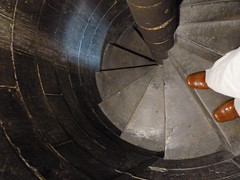 There's no better way to get a true appreciation of the scale and the construction of the dome than to climb it. There's almost always a line, but it's well worth the wait. After briefly viewing the vast interior of the cathedral, the climb begins inside the stone walls of the transept, ascending the first 150 feet mostly in tight spiral staircases of medieval stone. Near the top of this part, you enter a large room built into the transept that houses some of the original statuary from the façade that has been brought inside to protect it. In the equivalent room on the downside (you descend the opposite transept), some of Brunelleschi's hoisting inventions are on display.
There's no better way to get a true appreciation of the scale and the construction of the dome than to climb it. There's almost always a line, but it's well worth the wait. After briefly viewing the vast interior of the cathedral, the climb begins inside the stone walls of the transept, ascending the first 150 feet mostly in tight spiral staircases of medieval stone. Near the top of this part, you enter a large room built into the transept that houses some of the original statuary from the façade that has been brought inside to protect it. In the equivalent room on the downside (you descend the opposite transept), some of Brunelleschi's hoisting inventions are on display.
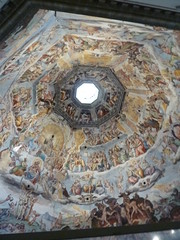
 At this point, you are at the level of the base of the dome, and you emerge to a walkway open to the interior of the church. Over the railing, you look down on the vast open church floor 170 feet below, while looking up into the dome, you have a ringside seat for the cavernous Last Judgment fresco. Swirling high above your head, rising toward the lantern of the dome, you see God in judgment, Christ, Mary, all the saints, choirs of angels, and symbolic representations of virtues, beautitudes, and signs of the end-times. Discomfitingly closer to where you stand is the darker underbelly of the apocalypse, with demons pulling wretched souls down to torture and damnation amidst symbols of sin and Hell. The enormous fresco, nearly 40,000 square feet of surface, is jam-packed with apocalyptic imagery. It was designed to be impressive when viewed from the pews 170 feet below, so you can imagine how fearsome it is when standing right at the base of it.
At this point, you are at the level of the base of the dome, and you emerge to a walkway open to the interior of the church. Over the railing, you look down on the vast open church floor 170 feet below, while looking up into the dome, you have a ringside seat for the cavernous Last Judgment fresco. Swirling high above your head, rising toward the lantern of the dome, you see God in judgment, Christ, Mary, all the saints, choirs of angels, and symbolic representations of virtues, beautitudes, and signs of the end-times. Discomfitingly closer to where you stand is the darker underbelly of the apocalypse, with demons pulling wretched souls down to torture and damnation amidst symbols of sin and Hell. The enormous fresco, nearly 40,000 square feet of surface, is jam-packed with apocalyptic imagery. It was designed to be impressive when viewed from the pews 170 feet below, so you can imagine how fearsome it is when standing right at the base of it.After walking partway around the base, you enter the interior of the dome itself, in passages that navigate between the internal dome and the external dome. At first, as you walk around, the curvature is slight, but as you ascend, the curvature closes in on you, with the passage not only bending more sharply, but with the walls of the passage leaning further and further in. Near the top, when you can't go around any more, the passage makes a turn straight for the center going up and across to the top of the dome. Along the way, you get to see pieces of Brunelleschi's techniques: the herringbone brickwork, the wooden and metal chains that function like the hoops on a barrel. And the whole inner/outer dome design is completely apparent because you're walking between the two.
On finally emerging at the top of the dome, you can walk around the base of the lantern topper, 350 feet above the ground, with commanding views of Florence and the surrounding countryside. This breathtaking panorama of the city, coupled with the fascinating insight into the architecture, is well worth climbing 463 stone steps.
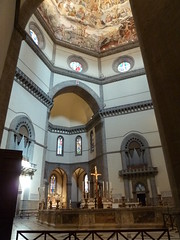
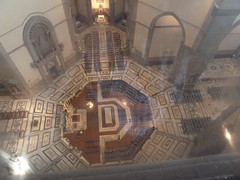

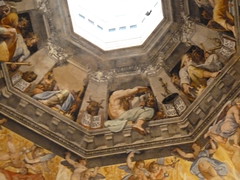

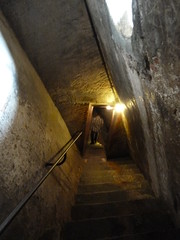
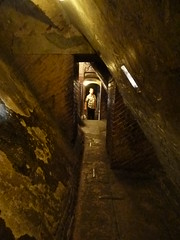
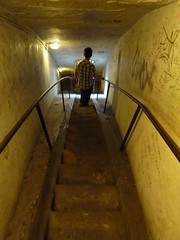
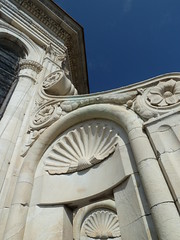

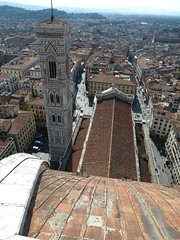

No comments:
Post a Comment